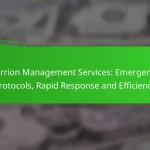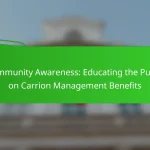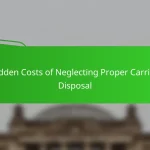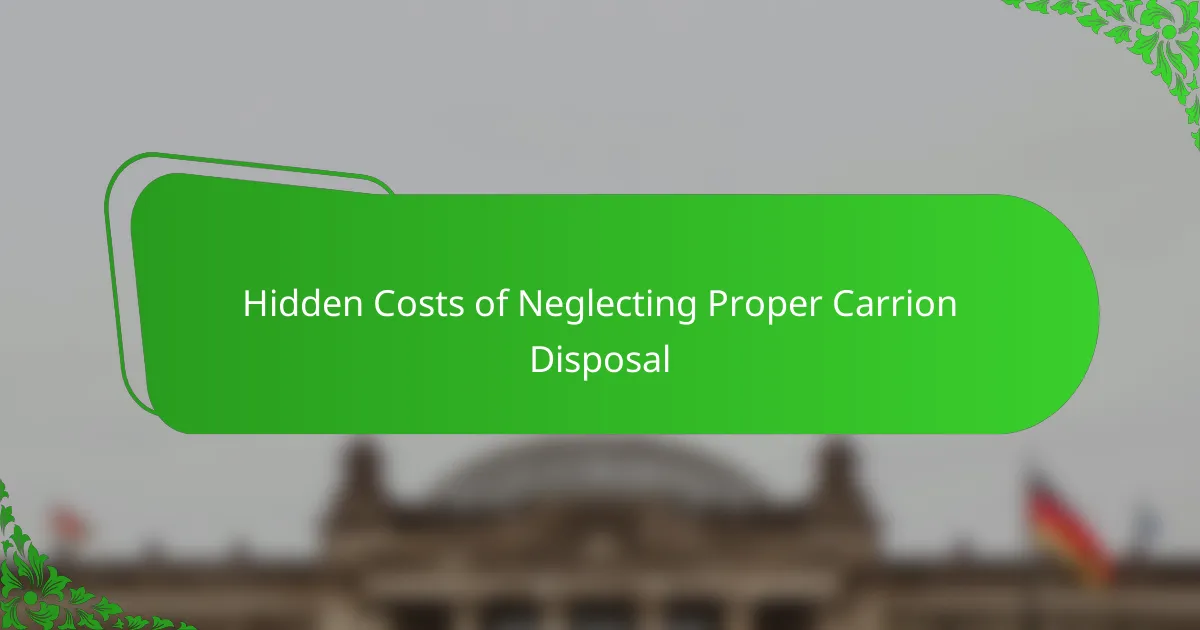Neglecting proper carrion disposal can result in significant hidden costs, such as environmental degradation, public health risks, and potential legal issues. These consequences often far exceed any initial savings gained from improper disposal methods, highlighting the importance of effective and responsible carrion management.

What are the hidden costs of neglecting proper carrion disposal?
Neglecting proper carrion disposal can lead to significant hidden costs, including environmental damage, public health threats, and legal repercussions. These costs often outweigh the initial savings from improper disposal methods.
Environmental contamination
Improper disposal of carrion can result in soil and water contamination, as decaying animal remains release harmful pathogens and chemicals. This contamination can affect local ecosystems, harming wildlife and disrupting natural processes.
For instance, if carrion is left in open areas, rain can wash toxins into nearby water sources, impacting both aquatic life and human water supplies. Regular monitoring and proper disposal methods can mitigate these risks.
Public health risks
Neglecting carrion disposal poses serious public health risks, as decomposing animals attract pests like rodents and insects, which can spread diseases. Common diseases associated with carrion include leptospirosis and salmonella, which can affect humans and pets alike.
To minimize health risks, it is crucial to dispose of carrion promptly and safely, following local regulations. Communities should educate residents on the importance of reporting dead animals to authorities for proper handling.
Legal liabilities
Failure to properly dispose of carrion can result in legal liabilities, including fines and penalties from local health departments or environmental agencies. Many jurisdictions have specific regulations regarding carrion disposal that must be adhered to.
Property owners and businesses should familiarize themselves with these regulations to avoid costly legal issues. Engaging professional disposal services can ensure compliance and reduce the risk of legal repercussions.
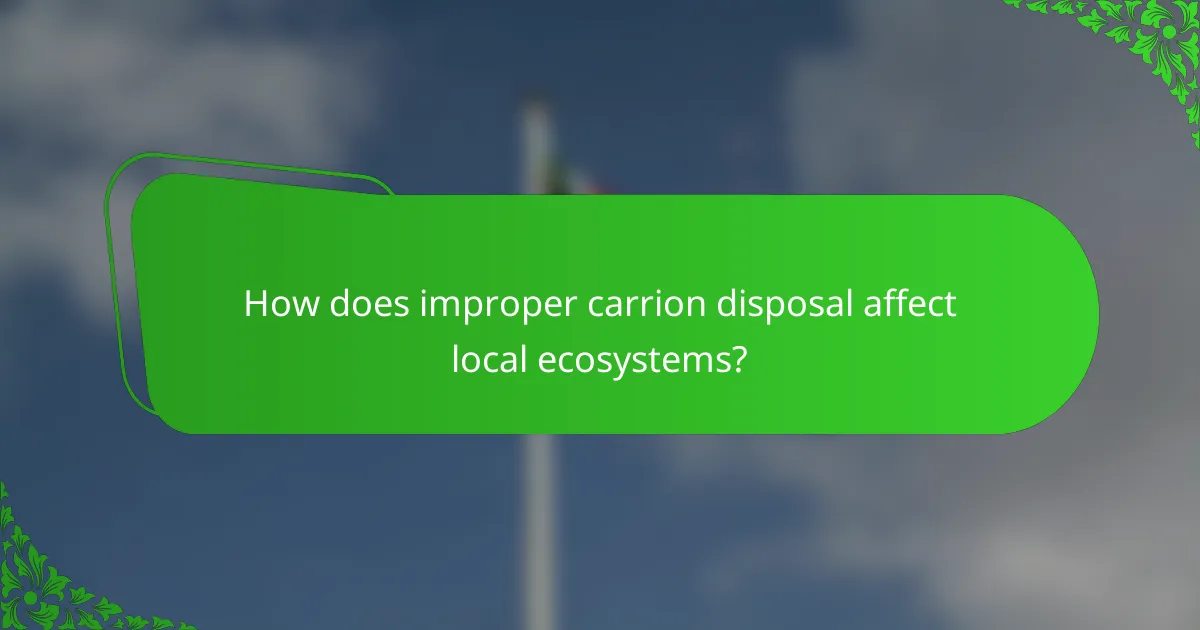
How does improper carrion disposal affect local ecosystems?
Improper carrion disposal can severely disrupt local ecosystems by altering food availability and encouraging disease spread. When animal remains are not disposed of correctly, it can lead to imbalances in predator-prey relationships and introduce pathogens into the environment.
Disruption of food chains
Improper disposal of carrion can lead to significant disruptions in local food chains. Scavengers, such as vultures and raccoons, rely on dead animals for sustenance; if carrion is not available, these species may struggle to find food, leading to population declines.
Additionally, the absence of natural scavenging can result in an overabundance of decomposing matter, which may attract pests and other opportunistic species. This imbalance can further affect the populations of other animals in the ecosystem.
Spread of diseases
Neglecting proper carrion disposal can facilitate the spread of diseases among wildlife and even humans. Decomposing animal remains can harbor pathogens, which can be transmitted to scavengers and other animals that come into contact with the carrion.
Common diseases associated with improper carrion disposal include avian influenza and rabies. To mitigate these risks, it is crucial to follow local regulations regarding animal disposal and to ensure that remains are buried or incinerated properly to prevent contamination of the surrounding environment.
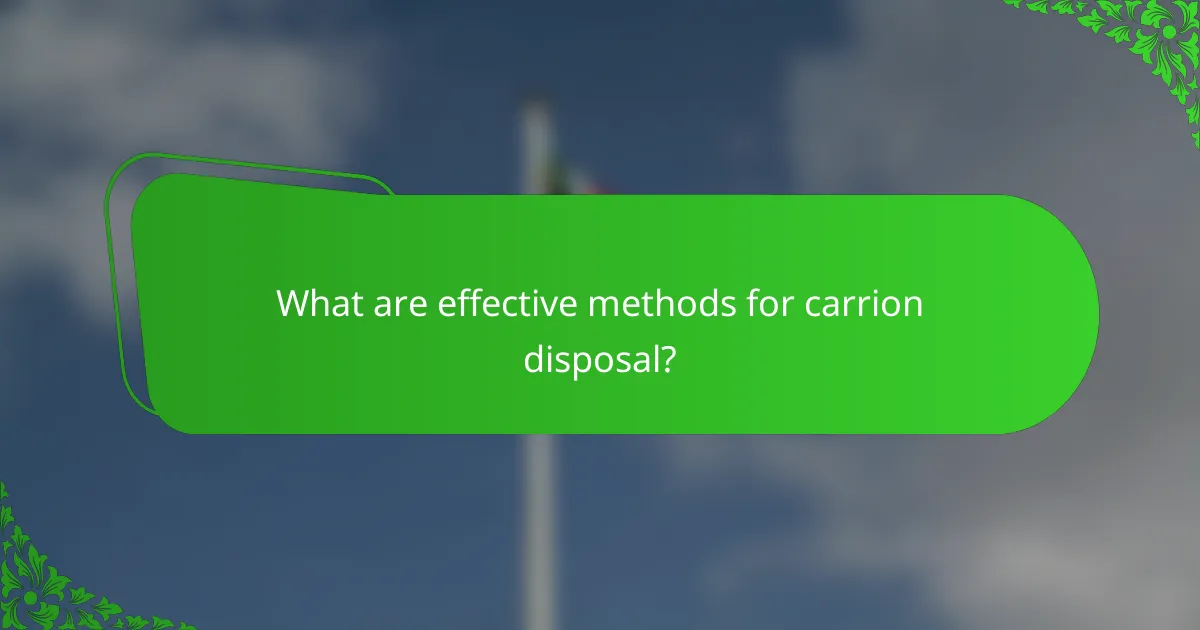
What are effective methods for carrion disposal?
Effective methods for carrion disposal include composting, rendering, burial, and incineration. Each method has its own benefits and considerations, making it essential to choose the right approach based on local regulations, environmental impact, and the specific circumstances of the disposal.
Composting
Composting is a natural process that transforms organic matter, including carrion, into nutrient-rich soil. This method requires a controlled environment with proper aeration, moisture, and temperature to facilitate decomposition.
When composting carrion, it’s crucial to layer the material with carbon-rich materials like leaves or straw to balance nitrogen levels. Ensure that the compost pile reaches a temperature of at least 55°C (131°F) to effectively kill pathogens and pests.
Rendering
Rendering involves heating animal carcasses to separate fats from proteins, producing usable byproducts like animal fat and meal. This method is commonly used in the food and pet food industries.
Rendering requires specialized equipment and adherence to local health regulations. It is efficient for large-scale disposal but may not be practical for individual cases due to costs and the need for industrial facilities.
Burial
Burial is a straightforward method where the carcass is buried in the ground, typically at least 1.5 meters (5 feet) deep to prevent scavenging. This method is often used in rural areas where other disposal options may not be available.
Before burying, check local regulations regarding burial depth and distance from water sources to avoid contamination. It’s important to select a site that minimizes environmental impact and complies with health standards.
Incineration
Incineration involves burning the carcass at high temperatures, reducing it to ash and gases. This method is effective for eliminating pathogens and is often used in urban settings where other disposal methods may pose risks.
Incineration requires specialized facilities and can be costly. Ensure compliance with local air quality regulations and consider the environmental impact of emissions when choosing this method.

What regulations govern carrion disposal in urban areas?
Carrion disposal in urban areas is regulated by a combination of local health department guidelines and state environmental regulations. These regulations aim to ensure public health and environmental safety by outlining proper disposal methods and practices.
Local health department guidelines
Local health departments typically set specific guidelines for carrion disposal to prevent health hazards. These guidelines may include requirements for timely removal of animal remains, designated disposal sites, and methods that minimize odor and attractants for scavengers.
For example, some municipalities may mandate that carrion be disposed of within 24 hours of discovery, while others may specify that remains must be buried at least one meter deep to avoid contamination of groundwater.
State environmental regulations
State environmental regulations often complement local guidelines by addressing broader ecological impacts of carrion disposal. These regulations may include restrictions on open burning of animal remains and requirements for reporting large animal deaths to prevent disease spread.
In many states, improper disposal can lead to fines or penalties, emphasizing the importance of compliance. For instance, regulations may require that disposal methods align with hazardous waste management practices if the animal is suspected to have been diseased.
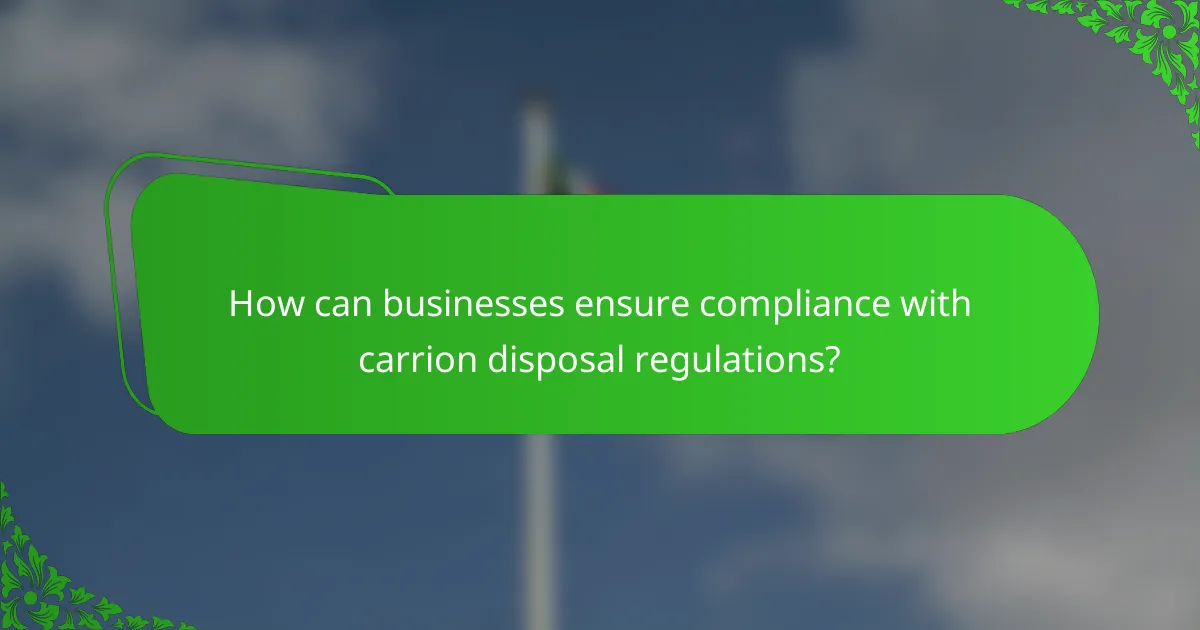
How can businesses ensure compliance with carrion disposal regulations?
Businesses can ensure compliance with carrion disposal regulations by implementing systematic procedures and training. Understanding local laws and engaging with certified disposal services are crucial steps in maintaining adherence to these regulations.
Regular training for staff
Regular training for staff is essential in ensuring that all employees are aware of the proper procedures for carrion disposal. Training sessions should cover local regulations, safety protocols, and the environmental impact of improper disposal. Frequent refreshers can help reinforce these practices and keep compliance top of mind.
Consider scheduling training at least once a year, with additional sessions whenever regulations change. Providing employees with clear guidelines and resources can help them understand their responsibilities and the importance of compliance.
Utilizing licensed disposal services
Utilizing licensed disposal services is a critical component of effective carrion disposal. These services are knowledgeable about local regulations and can ensure that disposal methods meet legal standards. Engaging with a licensed provider can also mitigate risks associated with improper disposal.
When selecting a disposal service, verify their credentials and ensure they comply with relevant environmental regulations. Comparing multiple providers can help identify the best fit for your business needs, considering factors like cost, reliability, and service offerings.

What are the costs associated with improper carrion disposal?
Improper carrion disposal can lead to significant financial and reputational costs for individuals and businesses. These costs include fines, cleanup expenses, and potential damage to public image, all of which can escalate quickly if not addressed promptly.
Fines and penalties
Neglecting proper carrion disposal often results in hefty fines imposed by local authorities. Regulations vary by region, but penalties can range from hundreds to thousands of dollars, depending on the severity of the violation and local laws.
In some jurisdictions, repeated offenses may lead to increased fines or even legal action. It’s crucial to stay informed about local disposal regulations to avoid these costly repercussions.
Cleanup costs
The financial burden of cleanup can be substantial if carrion is not disposed of correctly. Hiring professional services to manage the removal and decontamination of affected areas can cost several hundred to several thousand dollars, depending on the extent of the issue.
Additionally, delays in cleanup can exacerbate the problem, leading to further expenses related to health risks or environmental damage. Prompt action is essential to minimize these costs.
Reputation damage
Improper disposal of carrion can severely harm an individual or business’s reputation. Negative publicity can arise from community complaints or media coverage, leading to a loss of customer trust and potential business opportunities.
Restoring a tarnished reputation often requires significant investment in public relations efforts, which can be costly and time-consuming. Maintaining proper disposal practices is vital for protecting one’s image and ensuring community goodwill.

How can communities promote proper carrion disposal practices?
Communities can promote proper carrion disposal practices through education, collaboration, and enforcement of regulations. By raising awareness and providing resources, local governments and organizations can ensure that residents understand the importance of responsible disposal methods.
Public awareness campaigns
Public awareness campaigns are essential for educating community members about the significance of proper carrion disposal. These campaigns can utilize various media, including social media, flyers, and community events, to reach a broad audience.
Effective campaigns should focus on the health risks associated with improper disposal, such as the spread of disease and attracting pests. Providing clear guidelines on how to report dead animals and the proper disposal methods can empower residents to take action.
Communities can also partner with local veterinarians and wildlife organizations to host workshops or informational sessions, fostering a collaborative approach to carrion management. Engaging local schools in educational programs can further instill these practices in younger generations.
